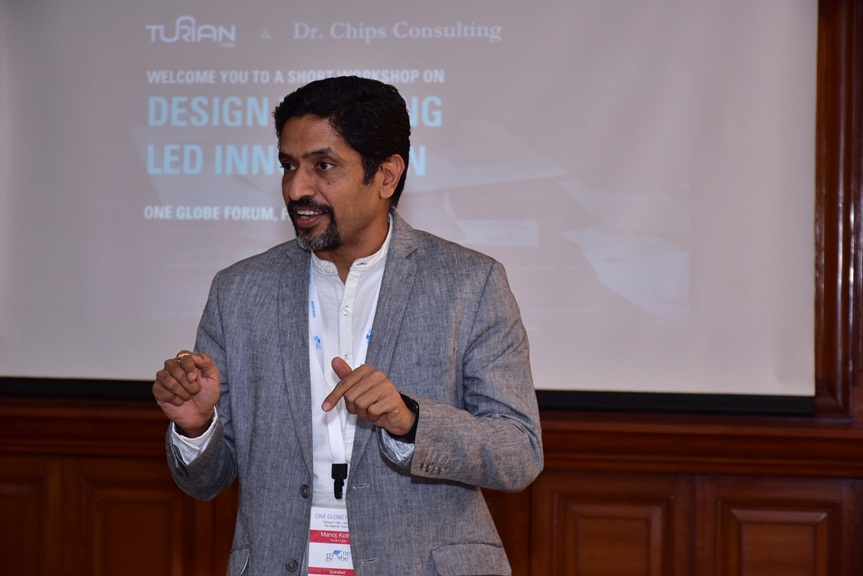Design Thinking for a better future
Posted by Admin on December 13, 2017BY: Manoj Kothari, MD & Principal Strategist, Turian Labs

Mr. Manoj Kothari
Design is not just what we see in coffee table books or on Apple billboards. It is a process that makes the world around us more efficient, comfortable, aesthetically appealing, and meaningful.
Recently Design Thinking has become a trending term in businesses and administrations across the world. Several Indian business icons have adopted Design Thinking as an important part of their organizational build, for example Vishal Sikka (CEO-Infosys), Atul Punj (Punj Lloyd), Ashni Biyani (Future Group), Ganpathy S. (SAP Labs), Nisa Godrej (Godrej group) etc. Once a cult, Design Thinking is now quickly becoming mainstream.
What is Design Thinking?
The practical application of design is Design Thinking. It is a process that helps solve tough problems & identify emerging opportunities, in a human-centered way.
Design Thinking, as a term, originated when the world realized that the way designers create new products is valuable, and can be used to solve tricky problems.
Design Thinking stands on four pillars: empathic insights, abductive reasoning, creative visualization, and recursive prototyping. Empathic insight involves connecting to the end-user without data biases. Abductive reasoning (starting with an observation and seeking to find the simplest explanation) ensures a ‘systems approach’ and a rapid convergence through leap of faith with successive hypotheses. Creative visualization ensures participation and brainstorming through pictures and visuals. Iterative prototyping ensures that new ideas are thoroughly tested, before the die is cast. Prototyping validates ‘early failure’.
How Does Design Thinking Work?
In the everyday life of an organization there are many examples of how ‘committees’ spoil the broth. Unless there is an over-arching central figure to control and moderate a discussion in the corporate realm, it falls apart in no time. Analysis-paralysis is a reality. People go on arguing till the cows come home, and to no avail.
Even if a decision is taken, it tends to be patchy and impulsive, only to be mended later at huge costs. Human beings are programmed to disown decisions taken by somebody else.
Design Thinking infuses a lot of situational protos, mockups or visuals in a discussion, which then become the rallying point for the problem or issue at hand. That helps bring out concerns even from the people who are less articulate (but can later pose a problem through their objections). This not only enriches the team insights but also creates a joint mandate for the decision.
Another important characteristic of an organization’s everyday life is a search for insight. Every problem today needs an insight. Organizations today have very few people who can have a ‘eureka’ moment every now and then, and come up with an effective solution. Today, the problems, from HR issues to consumer complaints, from innovation in products to rejuvenating brands, all need the piercing insight of a mind that can see through them.
What is Insight?
Data collation is not an insight. Data analysis is part of an insight but not an insight itself. An insight is bigger than the sum of the total findings. It requires a lateral connect between seemingly unconnected sets. This connection is not predictable at first. Some brains are wired to read between the lines as easily as reading the lines themselves. But how does an average cross-functional team make it happen? This is where Design Thinking comes into the picture. Methods of connecting the dots of micro-data and micro insights, and stitching them through ‘metaphor’ and not ‘function’, or through ‘story’ and not ‘organizational categories’, creates synthesis for a new meaning and new value.
Another important contribution of Design Thinking is in broadening the palette of ideas while brainstorming. Many times, brainstorming sessions reach a dead-end quickly with all the stakeholders only dishing out the predictable ideas. By studying the practices in other domains of human knowledge, deriving insights from observations and user-studies, and deeply analyzing the current context, practitioners can provide richer inputs on a brainstorming table. Not only that, their ideas and claims are likely to be backed by some observation (fact or piece of knowledge that has been recorded somewhere). This visualization generates a spring-board effect, where one person builds on another’s idea and takes it to a different level altogether. All ideas generated here may not be pragmatic, but, they will be diverse and vibrant enough to spark a new thought and a new beginning.
Recursive Protoyping is another key facet of Design Thinking. A prototype in Design Thinking parlance is not just a physical piece of contraption. It could just as well be a paper sketch, role-play, a series of words generated to model something, or a non-functioning installation.
Prototyping must be done at every stage of innovation and change, to cut the losses that might be incurred at later stages due to not conforming to the context. Life has gone from Excel sheets to enhanced digital tools which quickly model the products, services, task-flows and experiences in visual form. Rapid prototyping or 3D printing is increasingly becoming a tool of choice for giving ideas a quick shape.
Design Thinking is a process for doing things right when data and information is available in plenty, when creativity and consensus seem far apart, and society has gone well beyond its basic needs. The underlying thread is combining broad thinking with collaborative creativity.
The result is beauty, inclusivity, comfort, efficiency, cost optimization, and sighting of new opportunities. The world of possibilities is expanding every day and processes will come and go. Design Thinking is a reminder to not forget our species in the pursuit of efficiency and progress.
Happy Design Thinking!








